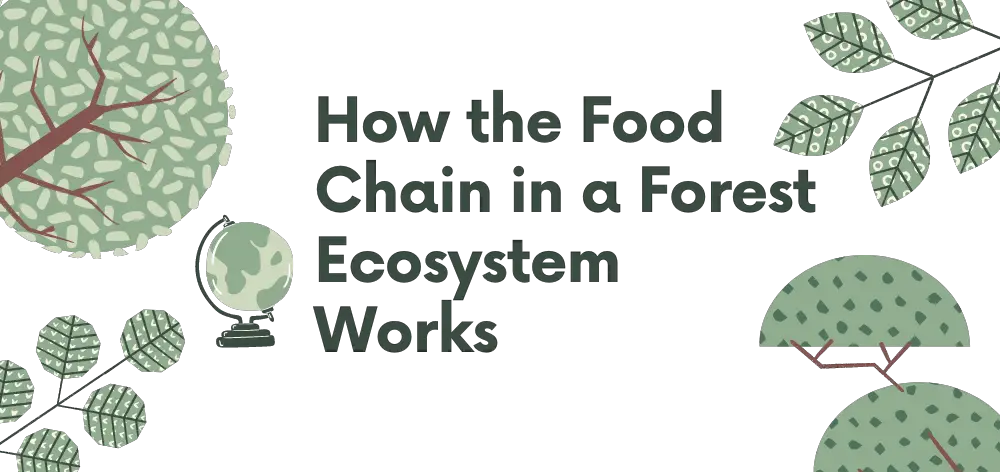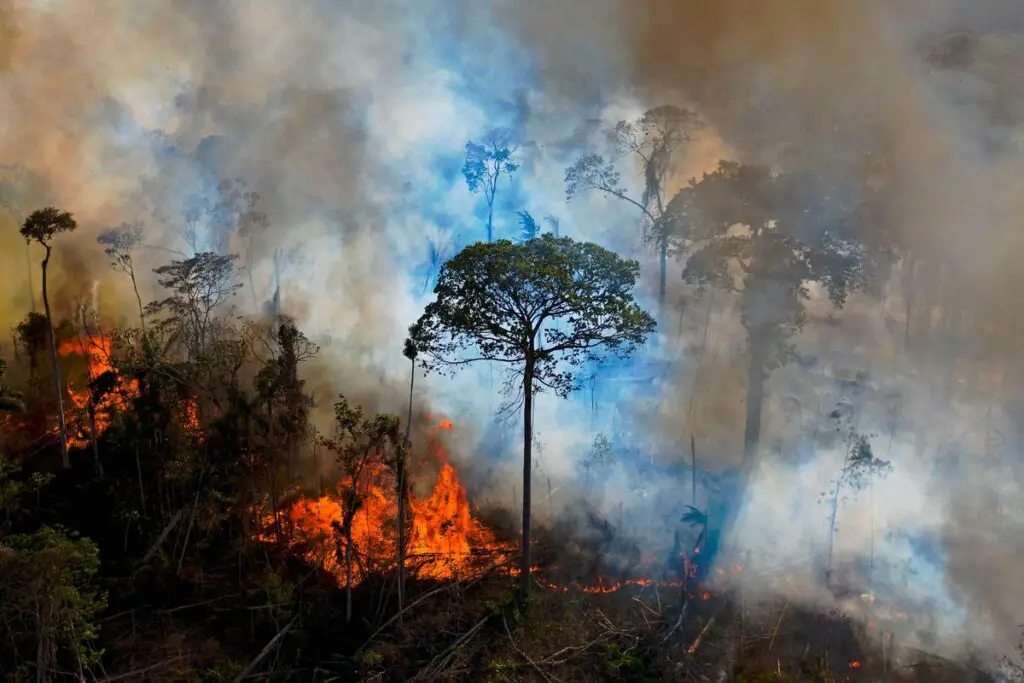A food chain is a fundamental concept in ecology that traces the flow of energy through different organisms within an ecosystem. At its core is the pivotal role of the sun, the primary source of energy. The sun provides light and warmth, driving photosynthesis in producers—organisms like plants and algae. These producers convert solar energy into food, forming the foundational tier of the food chain.
At its core, a food chain is a linear representation of the transfer of energy in an ecosystem. Picture it as a gastronomic relay, where each participant plays a specific role in passing sustenance along the chain.
The chain typically starts with **producers**, such as plants, harnessing energy from the sun through photosynthesis. This energy then flows through a sequence of organisms, with each step involving a predator-prey relationship.
In summary, a food chain illustrates the interconnected relationships among the sun, producers, consumers, and decomposers, emphasizing the delicate balance required for the sustainability of ecosystems. This concept highlights the dependency of all organisms on the sun’s energy and the intricate web of life that sustains our natural world.
Forest Food Web With 20 Organisms
In a forest Food Web, many different organisms contribute to the ecosystem’s overall health. Here is a list of 20 different organisms that play a role in a forest Food Web:
1. **Producers**: The green architects that capture sunlight and convert it into energy.
2. **Primary Consumers**: The herbivores that graze on the producers.
3. **Secondary Consumers**: Carnivores that feast on the primary consumers.
4. **Tertiary Consumers**: The top predators that maintain the delicate balance by keeping populations in check.
Food Chain Examples
Most people are familiar with the term food chain, but fewer can name one. A food chain is simply a linear network of links in which each organism eats the one below it and is eaten by the one above it. Food chains are found in all ecosystems and play an important role in moving matter and energy through these systems.
There are many different types of food chains, but most can be classified into two main categories: grazing and detrital. Grazing food chains begin with primary producers—plants that use photosynthesis to convert sunlight into energy. These plants are then consumed by herbivores, which are eaten in turn by carnivores.
Detrital food chains, on the other hand, begin with dead organic matter—detritus—which is decomposed by decomposers before being taken up by plants (primary consumers) and then animals (secondary consumers). There are also omnivorous food chains that include both grazers and detrital. Here are a few examples of different kinds of food chains:
- Grasshopper –> Sparrow –> Snake –> Hawk
- Algae –> Daphnia –> Trout –> Bear
- Bacteria –> Shrimp –> Tuna –> Blue whale
What are 5 Food Chain Examples?
A food chain is a linear network of links in a food web starting from producer organisms (such as green plants) and ending at apex predator species (like grizzly bears or killer whales), detritivores (like earthworms or woodlice), or decomposer species (such as fungi or bacteria). In every ecosystem, there are different food chains and each one is connected to another. The sun’s energy drives the production of organic matter, which flows through the food chains.
Producers, such as plants, convert the sun’s energy into chemical energy that they use to power their cells. Consumers then eat the producers and transfer that chemical energy into their own cells. Some animals are predators, which means they hunt other animals for food.
Other animals are prey, which means predators eat them. Detritivores break down dead plant and animal matter and return it to the soil where producers can use it again. Decomposers complete the process by releasing minerals back into the environment that plants can use to create new tissues.
Here are five examples of different types of food chains:
- Pond Ecosystem: Algae → Duckweed → Small Fish → Large Fish→ Heron
- Grassland Ecosystem: Grass → Gophers → Moles→ Snakes→ Hawks
- Desert Ecosystem: Cactus→ Lizards→ mice→ snakes→ hawks/owls
- Forest Ecosystem: Mosses → deer mice → shrews → snakes→ owls/bobcats
What is an example of a Food Chain in an Ecosystem?
In any ecosystem, food chains are always present. A food chain is simply a series of organisms in which each one serves as a food source for the next. In most cases, the first link in the chain is always an autotrophic organism, such as a plant.
These plants produce their own food through photosynthesis and are therefore at the bottom of the food chain. The next link in the chain would be a heterotrophic organism, such as an herbivore, which feeds on plants. The final link would be a carnivore, which feeds on other animals.
It’s important to remember that there can be many different food chains in any ecosystem – it all depends on what organisms are present and how they interact with each other. For example, in a forest ecosystem, there might be a main food chain that goes something like this:
Plants -> Herbivores (deer) -> Carnivores (bobcats).
What are 4 Food Chain Examples?
- One example of a food chain is algae -> zooplankton -> small fish -> big fish.
- Another example is grasshoppers -> mouse -> snake.
- A third example is kelp -> crab -> seal.
- The fourth and final example is phytoplankton -> krill -> whale.
What are the 3 Types of Food Chains?
In any ecosystem, there are three types of food chains: the grazing food chain, the detritus food chain, and the parasitic food chain. Grazing food chains begin with autotrophs—plants that make their own food from sunlight—and end with carnivores, animals that eat other animals. Detritus food chains start with dead plant and animal matter and end with decomposers like bacteria and fungi. Parasitic food chains have parasites as their top predators.
Food Chain in Grassland Ecosystem
A food chain is a linear network of links in a food web starting from producer organisms (such as grasses) and ending at apex predator species (like lions). A food chain also shows how the energy contained in organic matter moves through an ecosystem. The sun’s energy is converted into organic matter by producers like grasses.
Consumers like grazing animals, eat the grasses and convert the solar energy stored in them into new biomass. When predators eat these animals, the energy flows up the food chain to these top consumers. Some of this energy is lost at each level as heat so that less and less is available to support life higher up on the food chain.
In a grassland ecosystem, many different types of plants and animals interact with each other to form a complex web of life. Grasslands are found worldwide, from North America’s Great Plains to Africa’s Serengeti Plain. They are characterized by their dominant vegetation—grasses—and lack of trees.
Despite their name, grasslands actually support a great diversity of plant and animal life. In fact, some scientists consider them to be one of the most biologically diverse ecosystems on Earth! One reason for this high biodiversity is that grasses are very productive; they can convert large amounts of sunlight into biomass (organic matter).
This means more food is available for grazers—herbivores that eat plants—compared to other ecosystems, such as forests where shade-loving plants dominate. The abundance of grazers in turn supports populations of predators further up the food chain. The other reason for grassland ecosystems’ high biodiversity is their patchiness.
Grasses grow in clumps rather than evenly covering an area like trees do; this results in areas with more or less vegetation depending on local conditions such as soil type or rainfall patterns. This patchiness creates microhabitats where different species can live side-by-side; for example, tall grasses provide shelter for small mammals while short grasses allow turtles to bask in the sun. As you can see, even though they may look simple at first glance, grasslands are actually quite complex ecosystems!
Food Chain in Aquatic Ecosystem
A food chain is a linear network of links in a food web, from primary producers (such as autotrophs) to ultimate consumers (such as heterotrophs). Aquatic ecosystems are no different – they, too, have their own unique food chains. In this blog post, we will take a look at the aquatic food chain and explore how it works.
The aquatic food chain starts with primary producers, typically algae and plants that use sunlight to produce their own food. These primary producers form the base of the food chain and provide energy for all the other organisms in the ecosystem. Next are the primary consumers – small animals that eat the primary producers.
The most common type of primary consumer in an aquatic ecosystem is zooplankton. Zooplankton is tiny animals that drift around in the water, grazing on algae and plants. After the zooplankton, we have the secondary consumers.
These are larger animals that eat the zooplankton. The most common type of secondary consumer in an aquatic ecosystem is fish. Fish come in all shapes and sizes and play a vital role in keeping the ecosystem balanced.
Finally, at the top of the aquatic food chain are the tertiary consumers – these are predators that hunt and eat other animals. The most common type of tertiary consumer in an aquatic ecosystem is a shark or dolphin. Sharks and dolphins are apex predators, meaning they sit at the very top of the food chain with no natural enemies.
Food Chain for Forest Ecosystem
A food chain is a linear network of links in a food web, starting from primary producers (plants and other autotrophs) to secondary consumers (herbivores) and tertiary consumers (carnivores). A food chain also shows how organisms are related to each other by the food they eat. Each level in a food chain represents a trophic level.
A food web is an ecosystem’s interconnected and overlapping food chains. The sun provides energy for plants to grow through photosynthesis. Plants are eaten by herbivores, which are then eaten by carnivores or omnivores.
Decomposers break down dead plants and animals into organic matter that is recycled back into the ecosystem as nutrients for plants to grow. This energy flow from the sun to plants to herbivores to carnivores is called a food chain. In most ecosystems, many different types of plants and animals eat different things at different levels in the food chain. A complex network of these feeding relationships makes up a food web.
Frequently Asked Questions
What is the food chain of the forest?
In a forest ecosystem, the food chain consists of various interconnected levels, each dependent on the one below it. Producers are green plants, such as trees, shrubs, and grasses, that use sunlight, water, and carbon dioxide to produce their food through photosynthesis. They are the primary source of energy in the food chain.
What is the top of the food chain in the forest?
At the top of the food chain in a forest ecosystem, there are typically large predators or apex predators that have few or no natural predators themselves. These top predators play a crucial role in regulating the populations of other organisms and maintaining the balance of the ecosystem. The specific top predators in a forest can vary depending on the geographical location and ecosystem.
What is the food chain of the forest?
The food chain in a forest ecosystem typically consists of multiple interconnected food chains. Producers are plants and trees that convert sunlight, water, and carbon dioxide into energy through photosynthesis. They form the base of the food chain. Examples include grasses, shrubs, and trees like oak, pine, and maple.
Conclusion
The food chain is a key part of any ecosystem, and the forest is no different. In this blog post, we take a look at the food chain for a typical forest ecosystem. We start with the primary producers – the plants that use sunlight to produce energy-rich compounds.
These plants are eaten by herbivores, which in turn are eaten by carnivores. At each stage in the food chain, some energy is lost as heat – but there is still enough left over to support the next level up. Finally, we discuss how decomposers complete the cycle by breaking down dead organic matter and releasing nutrients back into the soil.
Related Articles
Insect Invasion: Threat to Utah’s Fir Forests
 Dr Ahsanur Rahman, PHD
Dr Ahsanur Rahman, PHD
UK Forests Collapse Imminent: Act Now Against Climate!
 Dr Ahsanur Rahman, PHD
Dr Ahsanur Rahman, PHD
Lightning Strikes Threat: Boreal Fires Jeopardize Carbon
 Dr Ahsanur Rahman, PHD
Dr Ahsanur Rahman, PHD











